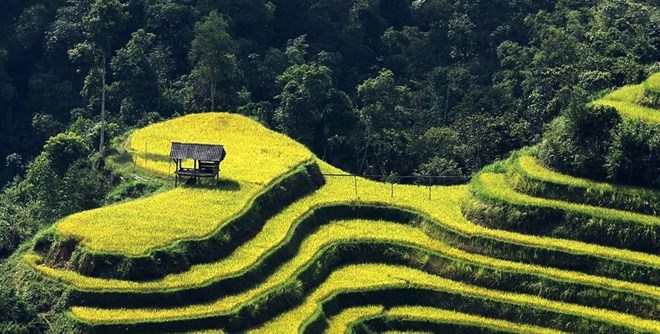
A cultural and tourism festival promoting the beauty of Hoang Su Phi’s terraced fields and ethnic culture is due to kick off in the northern mountainous province of Ha Giang on September 28.

The harvest season in Hoang Su Phi falls in September and October,
creating a breathtaking scene that attracts tourists to Ha Giang province every
autumn (Photo: VNA)
According to Vu Manh Ha, Secretary of Party Committee of Hoang Su Phi district,
the three-day event will include trade fairs introducing local specialties,
embroidery, weaving and cooking competitions for the La Chi group in Ban Phung
commune; ritual ceremonies of the Dao group in Ho Thau commune; and typical
festivals of the Mong group.
Visitors will be able to visit an ancient tea forest in Nam Pien commune, join
traditional dances with the Dao and Nung ethnic groups or go sightseeing at the
waterfall in Thuong village.
An indispensable part of the journey will be the golden Hoang Su Phi terraced
fields viewed from Nam Ty or San San Ho communes.
The harvest season in Hoang Su Phi falls in September and October, creating a
breathtaking scene that attracts tourists to Ha Giang province every autumn.
On November 1, 2011, the Ministry of Culture, Sports and Tourism recognised 760
hectares of Hoang Su Phi terraced fields located across six communes in the province
as a national heritage.
Source: VNA
With an increasingly vibrant and widespread emulation movement aimed at building cultured residential areas and cultured families, Yen Thuy District has been making steady progress toward improving both the material and spiritual well-being of its people, while fostering a civilized, prosperous, beautiful, and progressive community.
Once lacking recreational spaces and community facilities, Residential Group 2 in Quynh Lam Ward (Hoa Binh City) has recently received attention for the construction of a new, spacious, and fully equipped cultural house. The project followed the model of state support combined with public contributions in both labor and funding.
The "All people unite to build cultural life" movement, which has been effectively integrated with Kim Boi district’s socio-economic development goals, is fostering a lively spirit of emulation across local residential areas, hamlets, villages, public agencies, and enterprises. In addition, through the initiative, traditional cultural values are being preserved and promoted, while community solidarity and mutual support in poverty reduction and economic development are being strengthened.
A working delegation of the Hoa Binh provincial People’s Committee led by its Permanent Vice Chairman Nguyen Van Toan on June 11 inspected the progress of a project to build the Mo Muong Cultural Heritage Conservation Space linked to tourism services in Hop Phong commune, Cao Phong district.
Born and growing in the heroic land of Muong Dong, Dinh Thi Kieu Dung, a resident in Bo town of Kim Boi district, in her childhood was nurtured by the sweet lullabies of her grandmother and mother. These melodies deeply imprinted on her soul, becoming an inseparable part of her love for her ethnic group's culture. For over 20 years, this love for her hometown has driven Dung to research, collect, and pass down the cultural values of the Muong people to future generations.
In the final days of May, the Ethnic Art Troupe of Hoa Binh Province organized performances to serve the people in remote, mountainous, and particularly disadvantaged areas within the province. These were not just ordinary artistic shows, but they were the meaningful journeys aimed at spreading cultural values, enhancing the spiritual life of the people and contributing to the preservation of ethnic minority cultural identities.



